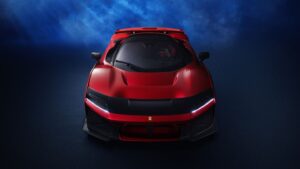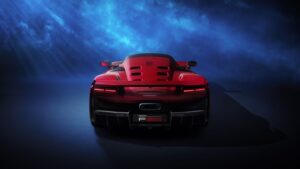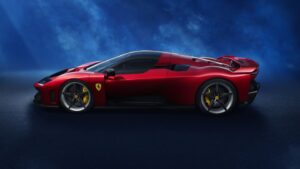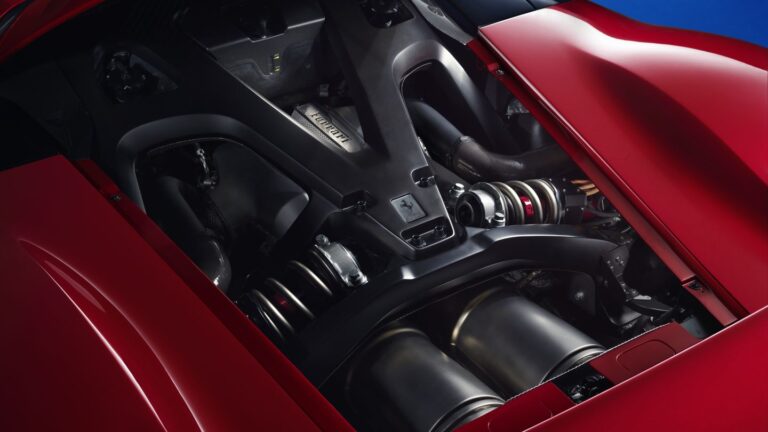Ferrari has unveiled the F80, its latest hypercar and flagship model. It features a 1,200hp 3.0-liter V6 engine with three electric motors for a powertrain setup that is straight out of F1 and WEC.
The engine
The F163CF is a 3.0-liter V6 that develops 900hp, making it the Ferrari engine with the highest specific power of all time (300hp/l). However, the engine gets additional boost from an electric front axle with two motors (e-4WD) and rear motor (MGU-K) to add another 300hp.
The architecture of the new engine and many of its components are closely derived from the 499P. Similarities include the crankcase, layout and drive chains of the timing system, oil pump recovery circuit, bearings, injectors and GDI pumps.
The F80 is the first Ferrari road car engine to benefit from a new approach for statistical knock control, which lets the engine operate even closer to the knock limit, enabling the use of higher combustion chamber pressures than ever (20% up on the 296 GTB).

A dedicated calibration was developed for each gear, enabling the engine to attain responsiveness comparable to a NA engine. The e-turbos, with an electric motor installed axially between the turbine and the compressor housing, enabled the engineers to optimize the fluid dynamics of the engine for maximum power at mid to high engine speeds without much turbo lag.
At the center of the combustion chamber sits the 350 bar injectors of the GDI system. This setup, with the multiple injection strategies adopted, ensures efficiency for outstanding performance with lower emissions. The intake and exhaust cam profiles have also been revised to optimize fluid dynamic efficiency and increase maximum engine speed to 9,000rpm, with a limiter at 9,200rpm.
Furthermore, both the intake and exhaust runners are polished for better performance, and the car features an Inconel exhaust manifold, designed to minimize pressure losses and tuned to emphasize the distinctive sound of a Ferrari V6. Inside, the steel crankshaft is machined from a die-cast element and features hot-forged crankpins with an offset angle of 120°. The firing order is 1-6-3-4-2-5 for a typical Ferrari tone.

To reduce weight, the crankshaft webs, counterweights, connecting rods and pistons have all been revised. The aluminum pistons were also revised – optimized to reduce weight and withstand the higher pressure and thermal loads in the combustion chamber due to the incredibly high torque and power. High-strength DLC (diamond-like carbon) coated steel has been used for the piston pin and a dedicated oil passage hole has been added to the zone between the piston pin and the connecting rod to improve lubrication.
The engine sits as close as physically possible to the flat undertray – as a result, none of the components at the bottom of the sump are more than 100mm below the centerline of the crankshaft. Ferrari also tilted the engine-transmission unit by 1.3° in the z-axis, to raise the gearbox so it doesn’t compromise the aerodynamic undertray.
The hybrid system
The design of the hybrid system (with two motors on the front axle and one at the rear of the car) draws directly from Ferrari’s experience in racing. The stator and rotor in a Halbach array configuration (which uses a special layout of the magnets to maximize magnetic field strength) and magnet sleeve in carbon fiber are derived from the design of the MGU-K in F1.
The system uses a DC-DC converter transforms DC current at one voltage to DC current at a different voltage. This technology makes it possible to use a single component to handle three different voltages simultaneously: 800V, 48V and 12V.

The front axle includes two electric motors, an inverter and an integrated cooling system. This combination makes it possible to use torque vectoring along with a weight saving of around 14kg over previous applications – the entire weight is 61.5kg. The rear electric motor (MGU-K) can start the internal combustion engine, recover energy to recharge the high-voltage battery and supplement the torque of the engine in certain dynamic conditions. It can generate up to 70kW in regeneration mode and assist the internal combustion engine with up to 60kW of power.
Using the direct current produced by the battery at 800V, the Ferrari converter generates direct current at 48V to power the active suspension and e-turbo systems, and 12V direct current to power the electronic control units and all other electric components. Innovative resonant technology enables this component to convert current with no latency with a conversion efficiency more than 98%. This also eliminated the need for a 48V battery, saving weight and simplifying the system.
The high-voltage battery is based on three principles: lithium-cell chemistry derived from Formula 1, an extensive use of carbon fiber for the construction of the monocoque casing, and a patented design and assembly method (cell-to-pack) that minimizes the weight and volume of the unit.
Finally, to improve integration between the electric and electronic internal components, Ferrari developed the CSC (Cell Sensing Circuit) wireless sensor suite, which monitors cell voltage with spring contacts and measures cell temperatures with infrared sensors.
Limited to 799 units, the hypercar is on sale at US$3.9m.
Click here to read more about the F80.


